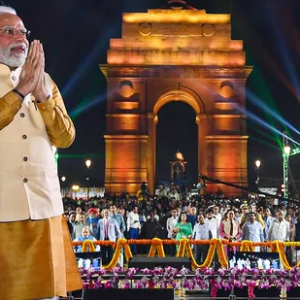Almost 80 people have lost their lives after being hunted down as witches in the last six years in Assam. Most of those who were killed were women. The popular narrative that exists regarding witch-hunting is that ‘superstitious tribal groups in the villages due to lack of education and scientific temperament target people as witches’. But why is that most victims are women? Mostly single, relatively well-to-do women. So, of course superstition has very little to do with it. Most of the survivors or their families we had spoken to pointed out the fact that the attacks were well-planned with the intent to usurp property or land. While witch hunting has existed in certain tribal groups such as the Mishings for centuries, the current practice of hunting women as witches goes beyond such age-old practices. Also, the practice is now spreading to non-tribal groups or tribal groups with no known history of witch hunting. What does this indicate then? A report by the organisation Partners in Law and Development, taking into account data from different states, says that 86 per cent of the primary targets of witch-hunting are women, and of these most fall in the age group of 40-60 years. So not just those women who are typically seen as vulnerable, such as single women and widows, but also the ones ‘secure’ in their marital families face the threat of witch-hunting.
North East Network (NEN) has been vociferous in demanding an anti-witch hunt legislation for the State but the bill has still not got the final approval. There are also other concerns around the present bill like a lack of nuanced understanding of the terms witchcraft and witchhunt, bez and ojha, both loosely used as terms for those who identify a certain person as a witch, and the differences between Assamese and Bodo languages. Activists worry that it does not focus enough on prevention. Professor Upen Rabha Hakasam of the department of folklore, Gauhati University, has personally faced the menace of witch-hunting as his own cousin, married in a well to do, highly educated household, had fallen prey to it. He says, ‘The British had been able to abolish the abhorrent practice of Sati by law. Why can’t our government use the law to abolish witch-hunting?’
The Making of a Witch
Women have been the face of evil in fairy tales and folklores for centuries, like Tejimola’s evil stepmother in one of Assam’s folktales. There are male ghosts too but in literature or motion pictures, the fear invoked by the woman with supernatural powers remains unmatched. Power in men is supposed to be a part of their natural being. There is a matter of factness about it. But women are inherently supposed to be defenceless and fragile. For them to have strong powers is an aberration. At times they are allowed to be wonder women, in ways that retain their attractiveness under the male gaze. But more frequently media and mythology suggest that they tend to get consumed by their own prowess more often than men. It is Eve who bit into the apple and because of her that all hell broke loose.
There are many ways in which this mystery, and then mistrust, around women’s capabilities gets built. In villages or cities, when there are programmes to raise awareness around reproductive issues men would keep out of it or would be asked to stay out. What happens is that instead of understanding there is fear or contempt for the reproductive capabilities of women’s bodies. One woman was targeted as a witch because during her menstruation she noticed some other emissions and when she went to a doctor about it, it became a matter of public knowledge and, soon, fear.
Then there is this hostility towards the hungry woman. She is the antonym to the woman who starves and fasts for others in the family and never says she is hungry even if she is malnourished. A woman who acknowledges this hunger and wants it satiated becomes a witch who feeds on the flesh and blood of others to strengthen herself. Anita Rabha, 58, lives in Baida village in Lakhipur block of Goalpara district. Years ago, a boy in her area suffered a dog bite. His father consulted a kobiraj, who acted like a traditional doctor for villagers. The kobiraj said that he would not be able to cure the boy. When the boy died, another kobiraj said that he had been eaten by a witch and pointed to Anita’s house. Perhaps it wasn’t an entire coincidence that this second kobiraj was related to Anita and her spouse, and had been in dispute with them over a piece of land. At this juncture, Anita received the support of her maternal family, who brought the couple to their home after they got driven out of their own house, but Birbal Rabha, her spouse, decided to separate from her. She now works at the local thana, the police station, washing utensils and clothes. She talks of how her younger son is finding it tough to pass the matriculation exam. Once he does, she says, he could get a driving licence and a job as a driver. Anita’s daughter, 22, is in her third year of college and had also been going to computer classes but is not studying at present because of a problem with her hand. One doctor has diagnosed her with arthritis. Wrenched away from her home and village and fending for herself and her children, Anita worries as her own age diminishes her capabilities. When she does get some time, she tries to attend meetings of AMSS, the Assam Mahila Samata Samiti, which has been staunchly fighting the practice of witch-hunting.
The Prejudice of the Educated
It is believed that lack of education is the cause of witch-hunting in villages. But are the educated free of prejudice? The headmaster of Baida Junior College, Listiram Rabha, is also the honorary founder principal there. When asked about the practice of witch-hunting he says, ‘When a dakini commits malpractices, she gets beaten up by the public. I would say they should not be killed. They should get a chance to rectify themselves’. He recalls having acted as a mediator in many cases and saved the practitioners of witchcraft from the public, and the public from the law.
He continues to talk about the practice of dark rituals, ‘There is an oppodevata, a god with a supernatural, malevolent force that some people tame. If this force is sent to harm someone, the person would fall so ill that no doctor would be able to cure him. The patient would then have to offer some sacrifice. Content with this offering, the force will then help the practitioner again in the future when they summon the god. I saw on television that in a lady’s house in Guwahati, curtains get set on fire. Such things are the work of the gods that I speak of. To tame such gods is a big art and Rabhas are experts in this’.
While he condemns the violent methods of witch-hunting, he speaks of the importance of education not in reforming the hunters but in transforming those he calls the practitioners, ‘Education is increasing. Tantric practices around here have gone down by about 60 per cent. People are going out to study but there aren’t as many women doing this. They should’.
Beyond the Law
But outside of the law too there have been attempts by artists to focus on the implications of witch-hunting, while activists use art to bolster their campaign. AMSS has travelled twenty villages with its play, along with putting up 200 awareness camps. There are films like Aei Maatite, Witch-Hunt Diaries and Jangfai Jonak.
Working for years now on ground zero, through village level branches called sanghas, members of the organisations say that there has been a decrease in the number of murders because of witch-hunting, though many cases of ostracisation and assault are still there. The survivors who would previously hesitate to report cases are much more confident now. They talk of instances when the police demanded affidavits from women saying they would not withdraw their complaints. Some survivors also end up joining the organisation. Women have started demanding property rights. AMSS members visit the homes of women employed as labour, as carpenters and stone cutters, and get them registered so they have economic stability and are not completely vulnerable or dependent. AMSS adds that the power wielded by ojhas has weakened, and people have started going more to doctors; health centres in villages have helped.
AMSS itself has faced assault by villagers, who feared that the organisation would report them to the police. They called the women witches and their leaders like Mamoni and Birubala head witches. But the organisation did not take legal action against them because they wanted people to realise what they were doing was wrong, which they ultimately did and apologised.
It’s Not Black and White
In trying to understand witch-hunting, if we look at each case carefully, there seem to be some immediate causes like deep-set prejudices against women, poor health, education and economic status, inter- and intra-familial rivalries, ignorance and superstition. But a superior, patronising approach of relegating these features only to certain sections of society, marginalised in terms of gender, social or economic status, won’t help. For example, there are enough incidents to show that the practice also goes on in families with ample money and education. So it is clear that something like non-conformism by women is punished across classes. In villages, women whose spouses treat them well, as equal partners, have been called witches. In cities, if a woman is loved and respected by her partner, she is asked what magic she had to resort to in order to keep the man in her ‘control’.
Similarly, rather than assuming that witch-hunting takes place in certain societies because they are ‘backward’ and uneducated would be taking a myopic view of things. In his paper ‘Assam’s Tale of Witch-hunting and Indigeneity’, Debarshi Prasad Nath makes some important larger connections, like linking witch-hunting to an aggressive, revivalist effort to establish cultural identities in a state where identity conflicts over resources are a common feature. Nath talks of how Bodo history doesn’t have records of witch-hunts. He relates the frequency of witch-hunting in Bodo communities to a possible attempt by Bodo people to integrate themselves with an ancient part of Assamese history. Nath’s paper suggests the possibility of witch-hunting being a skewed step towards a community’s resistance against a homogenisation imposed by majoritarian groups. The infamous witch-hunting incident that took place in Majuli in Assam comes to mind where for three days in 2013 even the police could/did not enter the area to intervene.
Along with a nuanced understanding of the triggers to witch-hunting while working with perpetrators, there also needs to be a patient unearthing of unsaid narratives of the survivors. NEN’s Anurita Pathak points out that in many cases the victims can hope to get some kind of justice only after they are dead. But witch-hunting is not just an isolated incident. It is often a protracted process that can also include sexual violence, stalking, disrobing, molestation, acid attacks and public humiliation, rejecting sexual advances being one of the causes. Due to stigma and resignation to the fact that the survivors have to continue to live amongst their attackers, many of these stories never come to the fore, leading to not just a denial of justice but also a never-articulated demand for it.
(Ankita Anand is a Delhi based scribe reporting on gender, labour and human rights. Nasreen Habib is the Editor of the Eclectic North East magazine)
(This article is carried in the print edition of May-June 2017 issue of India Foundation Journal)


